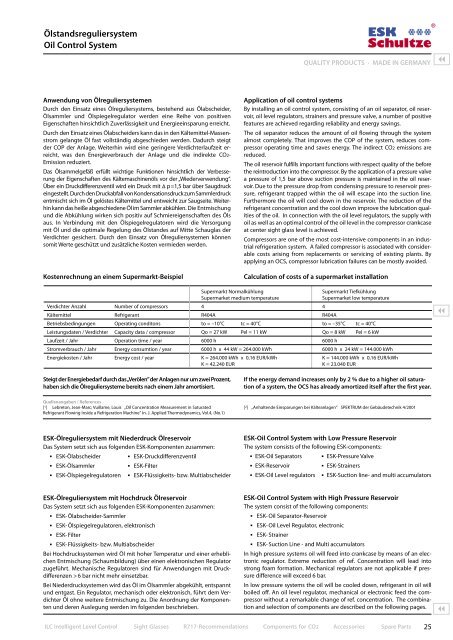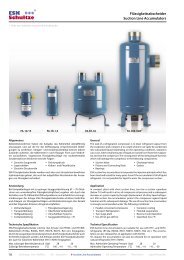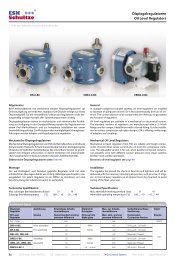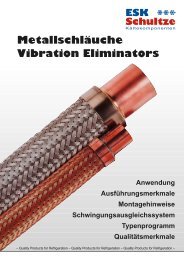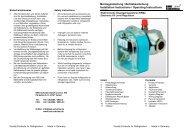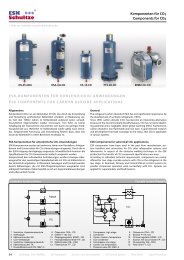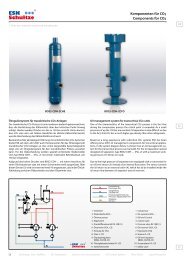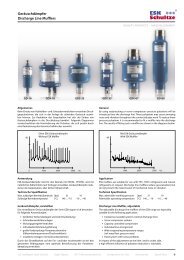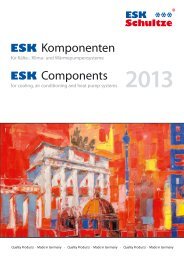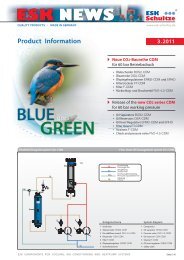ESK Katalog 2010 / Auflösung: 100 dpi - ESK Schultze
ESK Katalog 2010 / Auflösung: 100 dpi - ESK Schultze
ESK Katalog 2010 / Auflösung: 100 dpi - ESK Schultze
Sie wollen auch ein ePaper? Erhöhen Sie die Reichweite Ihrer Titel.
YUMPU macht aus Druck-PDFs automatisch weboptimierte ePaper, die Google liebt.
Ölstandsreguliersystem<br />
Oil Control System<br />
Anwendung von Ölreguliersystemen<br />
Durch den Einsatz eines Ölreguliersystems, bestehend aus Ölabscheider,<br />
Ölsammler und Ölspiegelregulator werden eine Reihe von positiven<br />
Eigenschaften hinsichtlich Zuverlässigkeit und Energieeinsparung erreicht.<br />
Durch den Einsatz eines Ölabscheiders kann das in den Kältemittel-Massenstrom<br />
gelangte Öl fast vollständig abgeschieden werden. Dadurch steigt<br />
der COP der Anlage. Weiterhin wird eine geringere Verdichterlaufzeit erreicht,<br />
was den Energieverbrauch der Anlage und die indirekte CO2-<br />
Emission reduziert.<br />
Das Ölsammelgefäß erfüllt wichtige Funktionen hinsichtlich der Verbesserung<br />
der Eigenschaften des Kältemaschinenöls vor der „Wiederverwendung“.<br />
Über ein Druckdifferenzventil wird ein Druck mit D p =1,5 bar über Saugdruck<br />
eingestellt. Durch den Druckabfall von Kondensationsdruck zum Sammlerdruck<br />
entmischt sich im Öl gelöstes Kältemittel und entweicht zur Saugseite. Weiterhin<br />
kann das heiße abgeschiedene Öl im Sammler abkühlen. Die Entmischung<br />
und die Abkühlung wirken sich positiv auf Schmiereigenschaften des Öls<br />
aus. In Verbindung mit den Ölspiegelregulatoren wird die Versorgung<br />
mit Öl und die optimale Regelung des Ölstandes auf Mitte Schauglas der<br />
Verdichter gesichert. Durch den Einsatz von Ölreguliersystemen können<br />
somit Werte geschützt und zusätzliche Kosten vermieden werden.<br />
Kostenrechnung an einem Supermarkt-Beispiel<br />
Steigt der Energiebedarf durch das „Verölen” der Anlagen nur um zwei Prozent,<br />
haben sich die Ölreguliersysteme bereits nach einem Jahr amortisiert.<br />
<strong>ESK</strong>-Ölreguliersystem mit Niederdruck Ölreservoir<br />
Das System setzt sich aus folgenden <strong>ESK</strong>-Komponenten zusammen:<br />
� <strong>ESK</strong>-Ölabscheider � <strong>ESK</strong>-Druckdifferenzventil<br />
� <strong>ESK</strong>-Ölsammler � <strong>ESK</strong>-Filter<br />
� <strong>ESK</strong>-Ölspiegelregulatoren � <strong>ESK</strong>-Flüssigkeits- bzw. Multiabscheider<br />
<strong>ESK</strong>-Ölreguliersystem mit Hochdruck Ölreservoir<br />
Das System setzt sich aus folgenden <strong>ESK</strong>-Komponenten zusammen:<br />
� <strong>ESK</strong>- Ölabscheider-Sammler<br />
� <strong>ESK</strong>- Ölspiegelregulatoren, elektronisch<br />
� <strong>ESK</strong>- Filter<br />
� <strong>ESK</strong>- Flüssigkeits- bzw. Multiabscheider<br />
Bei Hochdrucksystemen wird Öl mit hoher Temperatur und einer erheblichen<br />
Entmischung (Schaumbildung) über einen elektronischen Regulator<br />
zugeführt. Mechanische Regulatoren sind für Anwendungen mit Druckdifferenzen<br />
> 6 bar nicht mehr einsetzbar.<br />
Bei Niederdrucksystemen wird das Öl im Ölsammler abgekühlt, entspannt<br />
und entgast. Ein Regulator, mechanisch oder elektronisch, führt dem Verdichter<br />
Öl ohne weitere Entmischung zu. Die Anordnung der Komponenten<br />
und deren Auslegung werden im folgenden beschrieben.<br />
QUALITY PRODUCTS · MADE IN GERMANY<br />
Application of oil control systems<br />
By installing an oil control system, consisting of an oil separator, oil reservoir,<br />
oil level regulators, strainers and pressure valve, a number of positive<br />
features are achieved regarding reliability and energy savings.<br />
The oil separator reduces the amount of oil flowing through the system<br />
almost completely. That improves the COP of the system, reduces compressor<br />
operating time and saves energy. The indirect CO2 emissions are<br />
reduced.<br />
The oil reservoir fulfills important functions with respect quality of the before<br />
the reintroduction into the compressor. By the application of a pressure valve<br />
a pressure of 1,5 bar above suction pressure is maintained in the oil reservoir.<br />
Due to the pressure drop from condensing pressure to reservoir pressure,<br />
refrigerant trapped within the oil will escape into the suction line.<br />
Furthermore the oil will cool down in the reservoir. The reduction of the<br />
refrigerant concentration and the cool down improve the lubrication qualities<br />
of the oil. In connection with the oil level regulators, the supply with<br />
oil as well as an optimal control of the oil level in the compressor crankcase<br />
at center sight glass level is achieved.<br />
Compressors are one of the most cost-intensive components in an industrial<br />
refrigeration system. A failed compressor is associated with considerable<br />
costs arising from replacements or servicing of existing plants. By<br />
applying an OCS, compressor lubrication failures can be mostly avoided.<br />
Calculation of costs of a supermarket installation<br />
Supermarkt Normalkühlung Supermarkt Tiefkühlung<br />
Supermarket medium temperature Supermarket low temperature<br />
Verdichter Anzahl Number of compressors 4 4<br />
Kältemittel Refrigerant R404A R404A<br />
Betriebsbedingungen Operating conditons to = –10°C tc = 40°C to = –35°C tc = 40°C<br />
Leistungsdaten / Verdichter Capacity data / compressor Qo = 27 kW Pel = 11 kW Qo = 8 kW Pel = 6 kW<br />
Laufzeit / Jahr Operation time / year 6000 h 6000 h<br />
Stromverbrauch / Jahr Energy consumtion / year 6000 h x 44 kW = 264.000 kWh 6000 h x 24 kW = 144.000 kWh<br />
Energiekosten / Jahr Energy cost / year K = 264.000 kWh x 0,16 EUR/kWh K = 144.000 kWh x 0,16 EUR/kWh<br />
K = 42.240 EUR K = 23.040 EUR<br />
If the energy demand increases only by 2 % due to a higher oil saturation<br />
of a system, the OCS has already amortized itself after the first year.<br />
Quellenangaben / References<br />
[ 1] Lebreton, Jean-Marc; Vuillame, Louis „Oil Concentration Measurement in Saturated [ 2] „Anhaltende Einsparungen bei Kälteanlagen“ SPEKTRUM der Gebäudetechnik 4/2001<br />
Refrigerant Flowing Inside a Refrigeration Machine“ In. J. Applied Thermodynamics, Vol.4, (No.1)<br />
<strong>ESK</strong>-Oil Control System with Low Pressure Reservoir<br />
The system consists of the following <strong>ESK</strong>-components:<br />
� <strong>ESK</strong>-Oil Separators � <strong>ESK</strong>-Pressure Valve<br />
� <strong>ESK</strong>-Reservoir � <strong>ESK</strong>-Strainers<br />
� <strong>ESK</strong>-Oil Level regulators � <strong>ESK</strong>-Suction line- and multi accumulators<br />
<strong>ESK</strong>-Oil Control System with High Pressure Reservoir<br />
The system consist of the following components:<br />
� <strong>ESK</strong>- Oil Separator-Reservoir<br />
� <strong>ESK</strong>- Oil Level Regulator, electronic<br />
� <strong>ESK</strong>- Strainer<br />
� <strong>ESK</strong>- Suction Line - and Multi accumulators<br />
In high pressure systems oil will feed into crankcase by means of an electronic<br />
regulator. Extreme reduction of ref. Concentration will lead into<br />
strong foam formation. Mechanical regulators are not applicable if pressure<br />
difference will exceed 6 bar.<br />
In low pressure systems the oil will be cooled down, refrigerant in oil will<br />
boiled off. An oil level regulator, mechanical or electronic feed the compressor<br />
without a remarkable change of ref. concentration. The combination<br />
and selection of components are described on the following pages.<br />
ILC Intelligent Level Control Sight Glasses R717-Recommendations Components for CO2 Accessories Spare Parts<br />
25


